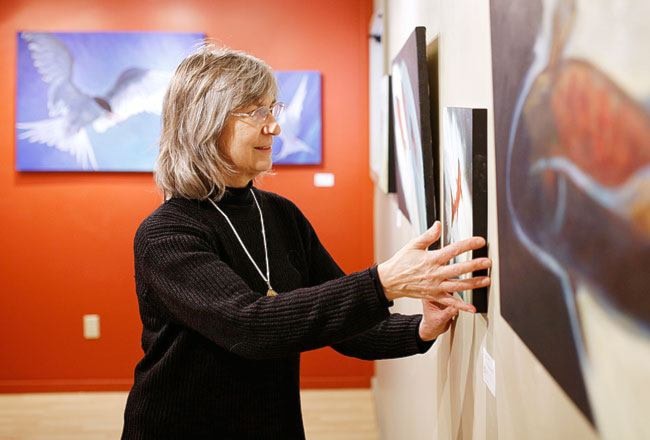When the Arctic tern makes a pit stop in Whitehorse on its way to its breeding grounds, it’s just a blip in the longest migration of any animal in the world.
The four-ounce bird, characterized by its orange-red bill and forked tail, follows a zigzagging route more than 70,000 kilometres between the poles every year.
The globetrotter is one of the species featured in Linda Leon’s new painting exhibit, Leap of Faith, which focuses on migratory birds and fish.
“It’s amazing how the whole planet is constantly on the move and you’re barely aware of it because we don’t pay attention,” she said.
Leon said the Arctic tern’s appearance always reminds her of Salvador Dali’s work, especially because he often painted birds with long wings and tails.
“I always thought they looked like a bird Dali would enjoy painting,” she said, “because their tail feathers swoop and they have long, elegant, pointy wings.”
Leon has often used animals as the subject of her paintings. In the past she’s painted foxes, grouse and bears.
But this time it was the impressive process of migration undertaken by certain species, including salmon and trumpeter swans, that inspired her.
Each spring, about 10 per cent of North America’s trumpeter swans stop at M’Clintock Bay in Marsh Lake during their migration.
Open water is the key for these returning birds, which can’t land on hard ground because they’re too heavy.
When the birds arrive in March, most Yukon rivers and lakes are locked under ice, as explained on the Environment Yukon website.
But at M’Clintock Bay they find shallow, open water filled with much-needed food. Warmer water from the bottom of Marsh Lake is forced to the surface, keeping the bay ice-free in all but the coldest months.
Leon said it’s amazing how, when the birds leave in early May, they know there will be open water at their next destination.
“Someone told me they get it wrong, sometimes,” she said with a laugh.
Leon’s exhibit also features Lapland longspurs, a small bird known for travelling in flocks of hundreds.
Unfortunately, they have a tendency to do this just as you’re driving by with your car, which often results in a few collisions, Leon said.
One day, Leon was coming back to Whitehorse from Faro after the annual crane and sheep viewing festival.
They were accompanied by Helmut Grunberg, a passionate birder and one of the founders of the Yukon Bird Club.
“We hit one of them and it was stuck in the front grille,” Leon said.
“Helmut carefully pried it out because he would stuff it and mount it on a stick to use as an educational tool for people. Their hind claws are very long and they really look like spurs.”
Living close to the Whitehorse Rapids Dam, Leon also enjoys watching and painting salmon, which take part in one of nature’s most impressive migratory journeys.
Each year, the Yukon River’s chinook salmon embark on the longest freshwater salmon migration in the world.
They enter from the Bering Sea into Alaskan waterways and make their way to the spawning grounds on the border of B.C. and Yukon, travelling more than 3,000 kilometres.
“I also go to the fish ladder at the end of every summer to watch them,” Leon said.
“They’ve been a part of human history for so long. That any of these creatures make it to their destination is a miracle.”
Leap of Faith opens on Friday, March 4 at the Yukon Artists at Work gallery. It runs until March 27.
Contact Myles Dolphin at
myles@yukon-news.com
